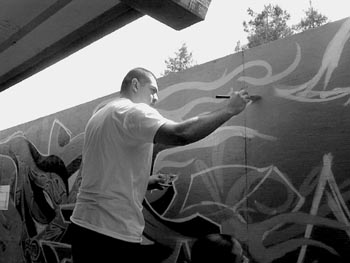![[Metroactive News&Issues]](/gifs/news468.gif)
[ San Jose | Metroactive Central | Archives ]
 Aerosol Kings Mountain View High School gives space to graffiti artists By J. Douglas Allen-Taylor A FEW WEEKS AGO, a motorcycle cop rolled up on the Mountain View High School campus, slightly freaking out a couple of teenage taggers who were busily spray-painting graffiti along a plywood wall at the back of the school. Twenty-year-old counselor Carlos Rodriguez smiled and told them to chill. "It's OK, man. We're legal." Legal and, for the most part, wanted. "There are some people in the community who don't want it here, but I like what they are doing," says Patricia Hyland, the school's principal. Her enthusiasm seems genuine. The six members of the school's United Styles club, under Rodriguez's direction, are covering a 40-foot temporary construction wall on the campus with spray-painted faces, masks, signatures and brightly colored images. Nearly half of the 40 wood panels have been finished. On one of the newly sun-splashed days of the new millennium, they line a narrow walkway where, during the lunch hour, a group of breakdancers performs while a local filmmaker videotapes the event for a documentary. The dancers, also sponsored by Rodriguez, have spread a piece of vinyl on the concrete and are whirling and contorting and handstanding to the blaring beat of hip-hop CDs, while a crowd of admiring students looks on, clapping at the most ambitious gyrations. One breaker gets so into it, he accidentally kicks the CD player off, signaling an end to his segment. Behind the dancers, the graffiti artists bend over their work with monklike intensity. There is little conversation except for brief consultation on form or style. Every once in a while, they check a sketchbook or a graffiti magazine for reference or inspiration. No one cracks a smile. This is serious work. Old-school schooldays were never like this. "Some people try to beat us down," a young dancer says to Kym Hoffschildt, who is filming the documentary. He is explaining the obstacles hip-hoppers must overcome. "They say we don't have a flow. But we just got to overcome that." A volunteer with the MACLA (San Jose's Center for Latino Arts) gang-awareness program, Rodriguez, who attended Leland High School, came to Mountain View High in November as an adolescent-pregnancy-prevention coordinator for at-risk Latino students. The project is sponsored by the North County Work Group of the Santa Clara County Adolescent Pregnancy Prevention Network and Proyecto Community Health Awareness Council. The graffiti mural and breakdance projects were his addition to the program. "When I got here, some teachers were doing a graffiti contest for the school magazine, but that fell through," Rodriguez says. "So we got permission to do the work on the construction wall." He began bringing graffiti magazines to school to give the students ideas. He says that the young artists are very intense. "When I got here, it was already their life," Rodriguez says. "I come out here at lunchtime, and some of them who don't have classes will stay and paint all afternoon. They'll come out on Saturday and work for three or four hours. Long as they can do graffiti without being busted, these guys are happy." He attributes the students' drive to the need to be recognized as artists. And he makes no apologies in referring to graffiti as art. "I define it as a means of expressing myself," he explains with passion. Comparing it to the work of Van Gogh, he says, "It can take all forms ... from abstract to surrealism. This is the new type of modern art--the art of the new millennium." He sees it as a passion that requires continuous study. "Right now, it's gone into three-dimensional form. I want to go to [San Jose] State [University] to learn graffiti sculpture. They're working with metal, wood and clay." He displays a tag he has drawn in a sketchbook that he hopes he can someday create as an object that you can hold in your hand. He expects the construction to last another year, at which time the temporary wall will come down. When that happens, Rodriguez plans to dismantle some of the better-painted panels to be installed in different parts of the valley. The documentary will become part of a graffiti-art show that Rodriguez hopes to put on. A longtime tagger himself, Rodriguez knows all about illegal aspects of the art. "Three years ago, I was underground," he says. "You always had to look around for the [park] rangers." [ San Jose | Metroactive Central | Archives ]
|
From the March 23-29, 2000 issue of Metro, Silicon Valley's Weekly Newspaper.
Copyright © 2000 Metro Publishing Inc. Metroactive is affiliated with the Boulevards Network.
For more information about the San Jose/Silicon Valley area, visit sanjose.com.